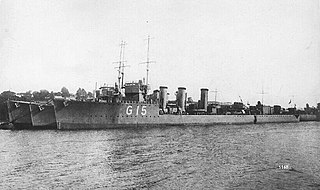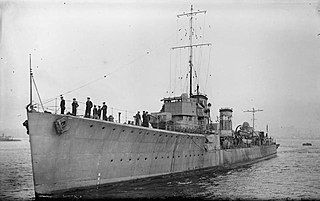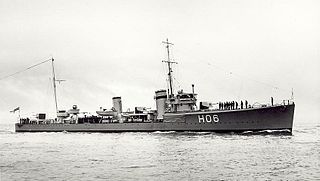HMS Starfish was an R-class destroyer which served with the Royal Navy. She was launched on 27 September 1916 and sold to be broken up on 21 April 1928. She was built by Hawthorn Leslie of Hebburn Tyne.

HMS Rosalind was an R-class destroyer which served with the Royal Navy. The ship was launched by Thornycroft on 14 October 1916 as the first of five similar ships ordered from the yard. The design was used as the basis for five subsequent ships of the S-class also built by the company. Rosalind served as part of the Grand Fleet during the First World War, operating as an escort to other warships and in anti-submarine patrols alongside other destroyers. The vessel was sold to be broken up on 13 July 1926.

HMS Ulster was a modified Admiralty R-class destroyer that served in the Royal Navy during the First World War. The Modified R class added attributes of the Yarrow Later M class to improve the capability of the ships to operate in bad weather. Launched on 10 October 1917, the vessel served with the Grand Fleet. After the war, the destroyer was placed initially in the Home Fleet, but then moved to the Reserve Fleet before, on 21 April 1928, being sold to be broken up.

HMS Ursula was a Modified Admiralty R-class destroyer that served in the Royal Navy. The Modified R class added attributes of the Yarrow Later M class to improve the capability of the ships to operate in bad weather. The vessel was launched in 1917 at Greenock in Scotland and served with the Grand Fleet during the First World War. After the war, the destroyer was transferred to the Home Fleet, but then moved to the Reserve Fleet. In 1924, Prince George served aboard Ursula before, in 1929, the vessel was sold to be broken up.

HMS Raider was the second of a class of sixty two R-class destroyers operated by the Royal Navy. Launched in 1916, the vessel served with the Grand Fleet during World War I. The destroyer was built as part of the preceding M-class but was equipped with geared turbines which improved efficiency and increased range. The ship was involved in anti-submarine patrols, but did not sink any German submarines. After the war, the destroyer initially moved to Harwich and was briefly stationed in Ireland after the Irish Civil War. In 1923, the Navy decided to retire the older destroyers in the fleet and, although initially spared, Raider was decommissioned and sold to be broken up in 1927.

HMS Romola was an R-class destroyer which served with the Royal Navy during World War I. Launched on 14 May 1916, the ship operated as part of the Grand Fleet, operating as part of a destroyer flotilla. The ship sailed to intercept the German High Seas Fleet in what would be one of the last major expeditions of their Navy in the war but saw no action. After the conflict, the destroyer was held in reserve until being retired and sold to be broken up on 13 March 1930.

HMS Tourmaline was an S-class destroyer, which served with the Royal Navy during the Greco-Turkish War and the Russian Civil War. Tourmaline was one of three destroyers ordered from Thornycroft in June 1917 with more powerful geared turbines than the majority of the class as well as design changes that improved seakeeping. Launched on 19 April 1919, the vessel operated as part of the Fourth Destroyer Flotilla serving with the Atlantic and Mediterranean Fleets. After serving in the Black Sea and Sea of Marmara, during which sister ships Speedy and Tobago were lost, Tourmaline led the Gibraltar Local Defence Flotilla. The London Naval Treaty, signed 1930, required the retirement of some destroyers to meet the Royal Navy's tonnage requirement and Tourmaline was chosen for retirement. The destroyer was decommissioned on 28 November 1931 after 12 years of service and broken up.

HMS Paladin was a Admiralty M-class destroyer which served with the Royal Navy during the First World War. The M class were an improvement on the previous L-class destroyer, capable of higher speed. Launched on 27 March 1916. Paladin took part in the Royal Navy sorties against German minesweepers in 1917, which culminated in the Second Battle of Heligoland Bight on 17 November, although the destroyer did not engage with any enemy warships during the battle. After the end of the war, the ship was placed in reserve before being decommissioned and sold to be broken up on 9 May 1921.

HMS Tara was an S-class destroyer, which served with the Royal Navy. Launched on 7 August 1918, the vessel entered service at the closing of the First World War. The ship joined the Fourteenth Destroyer Flotilla of the Grand Fleet but was placed in Reserve at Nore in 1919. Tara deteriorated over the following years and was sold to be broken up on 17 December 1931 after the signing of the London Naval Treaty that limited the amount of destroyer tonnage the Navy could retain.

HMS Trojan was an S-class destroyer, which served with the Royal Navy. The vessel was the only one named in honour of the citizens of Troy that has been operated by the navy. Launched on 12 July 1918, Trojan was too late to see service in the First World War. Initially allocated to the Grand Fleet and then, when this was dissolved, the Atlantic Fleet, the destroyer was transferred to the Reserve Fleet, like many of the class, within two years of being first commissioned. The vessel remained in reserve until 24 September 1936, although in a deteriorating condition. On that day, Trojan was sold to be broken up as part of a deal for the liner Majestic.

HMS Sepoy was an S-class destroyer, which served with the Royal Navy during the First World War and the Russian Civil War. Sepoy was launched in 1918 and initially joined the Grand Fleet. After the Armistice that ended the First World War, the ship was briefly transferred to the Reserve Fleet before sailing to Tallinn in 1919 as part of the Royal Navy response to the fighting there. Sepoy rejoined the Reserve Fleet at the end of the year. In 1922, the destroyer served in the Mediterranean Sea. The ship was later allocated to the naval base in Hong Kong, arriving in 1929. During exercises the following year, a depth charge explosion killed six sailors. The destroyer was also damaged. Following the signing of the London Naval Treaty a few days later, Sepoy returned to the United Kingdom and, in 1932, was sold to be broken up at Newport, Wales.

HMS Seraph was an S-class destroyer, which served with the Royal Navy during the Russian Civil War. The S class were a development of the previous R class, with minor differences, constructed at the end of the First World War. Seraph had a career as an evacuation vessel more than as a warship. Launched in 1918 by Denny, Seraph was originally destined for the Grand Fleet but, after the Armistice, the destroyer transferred to the Mediterranean Fleet based at Malta. The destroyer was sent into the Black Sea to support the White Russian forces in their fight against the Communists. The role involved supporting the movement of troops rather than firing at the enemy. Ultimately, the Communists won and Seraph helped the evacuation of White Russian troops from Crimea, returning to Malta in 1921. The destroyer was then stationed in the Eastern Mediterranean in 1923 in response to the tensions in Turkey. In 1927, the ship was sent to Hong Kong to serve under the Commander-in-Chief, China. In 1929, the vessel was once again called to evacuate, this time Christian missionaries from the Chinese Red Army. Once again, the evacuation took place without bloodshed. With the introduction of more modern destroyers, the Royal Navy started retiring the S class and, in 1934, Seraph was sold to be broken up.

HMS Sesame was an S-class destroyer, which served with the Royal Navy in the twentieth century. Launched on 30 November 1918 just after the end of the First World War, the ship was commissioned into the Reserve Fleet. A year later, the destroyer was sent to Latvia in support of the country's call for independence, arriving just at the cessation of that county's war of independence. Returning to the United Kingdom, Sesame was later equipped to act as a plane guard within the Home Fleet, with all armament removed and a davit fitted to rescue aircraft. The vessel remained in that configuration for a short time, but the London Naval Treaty sounded the death knell for the ship as it limited the destroyer tonnage that the Royal Navy could operate. As newer and more powerful destroyers entered service, Sesame was one of those retired, being sold to be broken up on 4 May 1934.

HMS Mameluke was an Admiralty M-class destroyer which served with the Royal Navy during the First World War. The M class was an improvement on the preceding L class, capable of higher speeds. The ship, the first Royal Navy vessel to be named after the Mamelukes, a class of ex-slaves that ruled Egypt, was launched in 1915. The destroyer joined the Twelfth Destroyer Flotilla and, although under refit during the Battle of Jutland and so unable to participate, later took part in anti-submarine operations as part of this flotilla, although no submarines were sighted or sunk. The conditions of service in the North Sea meant that the destroyer was soon worn out and, after the armistice, Mameluke was placed in reserve. Despite a service life of only six years, the vessel was decommissioned and, in 1921, sold to be broken up.

HMS Tancred was an R-class destroyer which served with the Royal Navy during the First World War. The R class were an improvement on the previous M class with geared steam turbines to improve efficiency. Launched by Beardmore of Dalmuir on 30 June 1917, Tancred initially joined the Grand Fleet, serving as part of a flotilla that took part in one of the last naval actions of the war, although in this case the British vessels did not engage with the German High Seas Fleet. After the signing of the Armistice that ended the war and the dissolution of the Grand Fleet, the destroyer was initially transferred to the Home Fleet. However, within a year, Tancred had been allocated to the local defence flotilla at Firth of Forth. Despite being at a reduced complement as an economy measure, further reductions in fleet costs meant that the destroyer was retired. On 17 May 1928, Tancred was sold to be broken up.

HMS Orestes was a Repeat Admiralty M-class destroyer which served in the Royal Navy during the First World War. The M class were an improvement on the previous L-class destroyer, capable of higher speed. The vessel was launched on 21 March 1916 and joined the Grand Fleet. Orestes was involved in seeking submarines in the North Sea, patrolling both independently and as part of large operations. The destroyer did not report any submarines destroyed, but did rescue the survivors from Q-ship Privet after that vessel had successfully sunk the submarine U-85 in a duel in March 1917. Later in the war, the focus was turned to escorting merchant ships and the destroyer helped secure convoys that crossed the Atlantic Ocean. After the Armistice that marked the end of the First World War, the destroyer was placed into reserve until being, on 30 January 1921, decommissioned and sold to be broken up.

HMS Hope was the first warship constructed by Swan Hunter and one of 20 Acorn class destroyers built for the Royal Navy that served in the First World War. The Acorn class were smaller than the preceding Beagle class but oil-fired and better armed. Launched in 1910, Hope served with the Second Destroyer Flotilla of the Grand Fleet as an escort based at Devonport for most of the war, protecting ships like RMS Aquitania, until being transferred to Malta to serve with the Fifth Destroyer Flotilla as part of the Mediterranean Fleet in 1917. Hope collided with and sank the destroyer HMS Arno in 1918. After the Armistice, the destroyer continued to serve in Malta under being sold in 1920.

HMS Sheldrake was one of 20 Acorn-class destroyers built for the Royal Navy. The destroyer served in the First World War. The Acorn class were smaller than the preceding Beagle class but oil-fired and better armed. Launched in 1910, Sheldrake served with the Second Destroyer Flotilla of the Grand Fleet as an escort, transferring to Malta to serve with the Fifth Destroyer Flotilla as part of the Mediterranean Fleet in 1916. The ship once again served as an escort, protecting ships from submarines and mines, including the troopship Ivernia, as well as unsuccessfully attempting to rescue the sloop Nasturtium. After the Armistice, the destroyer was reduced to reserve before being sold to be broken up in 1921.

HMS Seabear was an S-class destroyer that served with the Royal Navy during the Russian Civil War. The S class was a development of the previous R class, with minor differences, constructed at the end of the First World War. Seabear was launched in December 1917 and joined the Grand Fleet for the last few months of the War. The destroyer then joined the British campaign in the Baltic, sailing as part of a detachment of ten destroyers under the command of Admiral Walter Cowan in March 1919. Seabear sailed to Tallinn in support of the Estonian War of Independence the following month. On returning to the UK, the ship was placed in reserve. The London Naval Treaty limited to number of destroyers that the Royal Navy could operate and, as new ships entered service, older vessels were retired. Seabear was sold in February 1931 and broken up.

HMS Searcher was an S-class destroyer that served with the Royal Navy during the Russian Civil War. The S class was a development of the previous R class, with minor differences, constructed at the end of the First World War. Searcher was launched in September 1918 and joined the Grand Fleet days after the end of the War. The destroyer then joined the British campaign in the Baltic, sailing as part of a detachment of ten destroyers under the command of Admiral Walter Cowan in March 1919. Searcher sailed to Tallinn in support of the Estonian War of Independence the following month. On returning to the UK, the ship was placed in reserve. In 1931, the destroyer resumed active service and joined the defence flotilla at Gibraltar, and, subsequently, the Mediterranean Fleet, accompanying ships like the aircraft carrier Glorious and the dreadnought Queen Elizabeth on cruises around the Mediterranean Sea. The vessel also took part in the naval review to celebrate the Silver Jubilee of George V in 1935. Searcher was sold to be broken up in 1938.
















